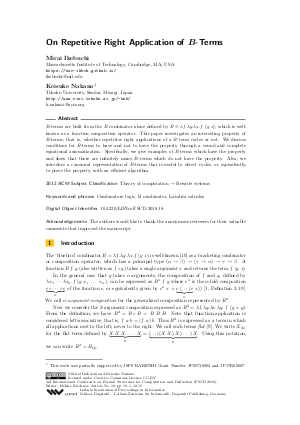On Repetitive Right Application of B-Terms
Authors Mirai Ikebuchi, Keisuke Nakano
-
Part of:
Volume:
3rd International Conference on Formal Structures for Computation and Deduction (FSCD 2018)
Part of: Series: Leibniz International Proceedings in Informatics (LIPIcs)
Part of: Conference: Formal Structures for Computation and Deduction (FSCD) - License:
 Creative Commons Attribution 3.0 Unported license
Creative Commons Attribution 3.0 Unported license
- Publication Date: 2018-07-04
File

PDF
LIPIcs.FSCD.2018.18.pdf
- Filesize: 456 kB
- 15 pages
Document Identifiers
Subject Classification
ACM Subject Classification
- Theory of computation → Rewrite systems
Keywords
- Combinatory logic
- B combinator
- Lambda calculus
Metrics
- Access Statistics
-
Total Accesses (updated on a weekly basis)
0Document
0Metadata
Abstract
B-terms are built from the B combinator alone defined by B == lambda f.lambda g.lambda x. f~(g~x), which is well-known as a function composition operator. This paper investigates an interesting property of B-terms, that is, whether repetitive right applications of a B-term cycles or not. We discuss conditions for B-terms to have and not to have the property through a sound and complete equational axiomatization. Specifically, we give examples of B-terms which have the property and show that there are infinitely many B-terms which do not have the property. Also, we introduce a canonical representation of B-terms that is useful to detect cycles, or equivalently, to prove the property, with an efficient algorithm.
Cite As Get BibTex
Mirai Ikebuchi and Keisuke Nakano. On Repetitive Right Application of B-Terms. In 3rd International Conference on Formal Structures for Computation and Deduction (FSCD 2018). Leibniz International Proceedings in Informatics (LIPIcs), Volume 108, pp. 18:1-18:15, Schloss Dagstuhl – Leibniz-Zentrum für Informatik (2018)
https://doi.org/10.4230/LIPIcs.FSCD.2018.18
BibTex
@InProceedings{ikebuchi_et_al:LIPIcs.FSCD.2018.18,
author = {Ikebuchi, Mirai and Nakano, Keisuke},
title = {{On Repetitive Right Application of B-Terms}},
booktitle = {3rd International Conference on Formal Structures for Computation and Deduction (FSCD 2018)},
pages = {18:1--18:15},
series = {Leibniz International Proceedings in Informatics (LIPIcs)},
ISBN = {978-3-95977-077-4},
ISSN = {1868-8969},
year = {2018},
volume = {108},
editor = {Kirchner, H\'{e}l\`{e}ne},
publisher = {Schloss Dagstuhl -- Leibniz-Zentrum f{\"u}r Informatik},
address = {Dagstuhl, Germany},
URL = {https://drops.dagstuhl.de/entities/document/10.4230/LIPIcs.FSCD.2018.18},
URN = {urn:nbn:de:0030-drops-91882},
doi = {10.4230/LIPIcs.FSCD.2018.18},
annote = {Keywords: Combinatory logic, B combinator, Lambda calculus}
}
Author Details
- Massachusetts Institute of Technology, Cambridge, MA, USA , https://mir-ikbch.github.io/
Funding
- Nakano, Keisuke: This work was partially supported by JSPS KAKENHI Grant Number JP25730002 and JP17K00007.
References
-
Hendrik P. Barendregt. The Lambda Calculus: Its Syntax and Semantics. Studies in Logic and the Foundations of Mathematics. Elsevier Science, 1984.

-
Michael Beeler, Ralph W. Gosper, and Richard C. Schroeppel. HAKMEM. Technical report, Massachusetts Institute of Technology, Cambridge, MA, USA, 1972.

-
Richard P. Brent. An improved Monte Carlo factorization algorithm. BIT, 20(2):176-184, 1980.

-
Haskell B. Curry. Grundlagen der Kombinatorischen Logik (Teil II). American Journal of Mathematics, 52(4):789-834, 1930.

-
Sachio Hirokawa. Principal types of BCK-lambda-terms. Theoretical Computer Science, 107(2):253-276, Jan 1993.

-
Donald E. Knuth. The Art of Computer Programming, Volume 2 (3rd Ed.): Seminumerical Algorithms. Addison-Wesley Longman Publishing Co., Inc., Boston, MA, USA, 1997.

-
Evgeny S. Ljapin. Semigroups. Translations of Mathematical Monographs. American Mathematical Society, 1968.

- Keisuke Nakano. ρ-property of combinators. 29th TRS Meeting in Tokyo, 2008. URL: http://www.jaist.ac.jp/~hirokawa/trs-meeting/original/29.html.
-
Chris Okasaki. Flattening combinators: surviving without parentheses. Journal of Functional Programming, 13(4):815-822, July 2003.

-
Raymond M. Smullyan. To Mock a Mockingbird. Knopf Doubleday Publishing Group, 2012.

-
Rick Statman. The Word Problem for Smullyan’s Lark Combinator is Decidable. Journal of Symbolic Computation, 7(2):103-112, 1989.

- Rick Statman. To Type A Mockingbird. Draft paper available from http://tlca.di.unito.it/PAPER/TypeMock.pdf, December 2011.
-
Johannes Waldmann. Personal communication, March 2013.

